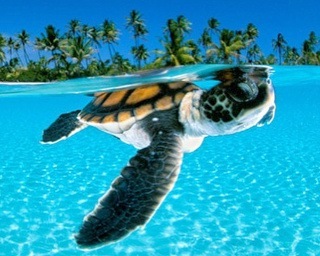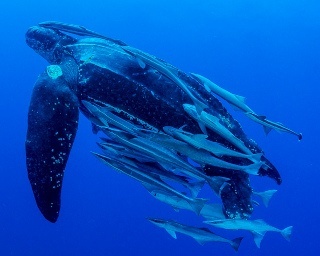World Turtle Day was started in 2000 by the American Tortoise Rescue organisation. The aim of this special day is to share information about this species and create respect for tortoises and turtles that will enable them to survive and thrive. Here are ten fascinating facts about these ancient and endangered reptiles.
They are some of the oldest animals on earth
There is fossil evidence that tortoises have roamed the earth for more than 200 million years. Slightly ‘younger’, turtles have swam our oceans for approximately 150 million years.
 They are amphibious
They are amphibious
Turtles spend the majority of their lives in the oceans. Females come ashore, usually to the same beach where they hatched, to lay their eggs in nests. 60 days after the eggs are laid, the hatchlings emerge and make their way into the ocean.
Seven is the lucky number for sea turtles
There are seven species of sea turtles: green, hawksbill, leatherback, loggerhead, olive ridley, Kemp’s ridley and flatback.
Not-so-cold-blooded leatherback turtle
The majority of reptiles are cold blooded, however there are a few exceptions. The leatherback turtle has a unique ability to regulate its body temperature to some degree.
They have a shell akin to an armoured tank
Turtles and tortoises have survived through many natural catastrophes. Humans are adult turtles biggest threat. We eat their eggs, make soup from their meat and pollute their habitats.
Lonesome George is the the symbol for conservation in the Galapagos Islands
Lonesome George was ‘the rarest animal alive’ according to the Guinness Book of World Records. He was a giant male Galapagos tortoise and the last remaining specimen of the Pinta Island tortoise. George passed away in June 2012 and now serves as a potent symbol for conservation in the Galapagos Islands.
They have been space travellers
In 1968, two Russian tortoises survived a trip around the moon and back!
 From the gigantic to the minuscule
From the gigantic to the minuscule
Leatherback turtles can grow up to 1.9 metres long and weigh as much as 900kg, while its distant cousin, the male speckled cape tortoise is tiny in comparison at just 8 centimetres in length.
A ‘speedy’ turtle
Speedy is not what most people will associate with turtles. Leatherbacks, despite their substantial size, can swim up to 35km per hour when the need arises.
They are long distance swimmers
According to WWF, a leatherback female turtle once swam from Papua in Indonesia to the north west coast of the United States and back again. A total journey of 19 000 kilometres!
We recommend diving holidays in Thailand, Malaysia, the Maldives, Indonesia and Fiji for scuba diving with turtles. Contact Dive The World right away on +66 (0)94 582 7973 / (0)83 505 7794 or send us an email.